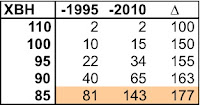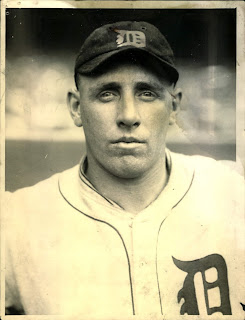Snider is clearly a poster boy for the concept of "peak" performance as a ticket into the Hall of Fame. There is probably no player whose mid-career home park shift was so severe, but the BBWAA voters (at least implicitly) recognized this when they inducted him in 1980. (They also waited until the enshrinement of both Mickey Mantle and Willie Mays, those "other New York center fielders" from "The Era" when the Big Apple owned baseball--a team from New York appeared in ten of eleven post-seasons from 1947-57 and represented both leagues in seven World Series during that time frame.)
So what happened to Snider? A look at the daily data points to two things: the Coliseum, of course, which forced Duke to change his approach at the plate; and a set of nagging injuries that caused him to age prematurely.
 In 1958, the Dodgers sure weren't ready to make the move to Los Angeles. The team lost 21 of its first 31 games, and manager Walt Alston was juggling players and lineups at an accelerated rate (the '56 Dodgers had used only 46 different lineups; the '58 team would use 96.)
In 1958, the Dodgers sure weren't ready to make the move to Los Angeles. The team lost 21 of its first 31 games, and manager Walt Alston was juggling players and lineups at an accelerated rate (the '56 Dodgers had used only 46 different lineups; the '58 team would use 96.)Snider didn't even start out the year playing center field. He and Gino Cimoli (who, coincidentally, also passed away this month) were flip-flopped by Alston. Snider hit a home run at Seals Stadium in the second game of the 1958 season--and didn't hit another one until May 31st. He found his stroke in June, but regressed in July, still tinkering with his swing at the Coliseum. He seemed to put it all together in August, but suffered through nagging injuries until he twisted his knee while running the bases in mid-September.
What might be shocking to us now is to see how swiftly the Dodgers began to platoon the Duke. The injury-plagued '58 campaign, in which he's missing about forty percent of his usual plate appearances, masks the fact that the switch in ballparks resulted in a reversal of strategy for the Dodgers' opponents. In 1957, left-handed pitchers had made only 6 starts against the Dodgers. In 1958, that total was 25. By 1961, it was 35. While this was still at the bottom of the NL, the 1960 Dodgers had five times as many plate appearances against left-handed starters than the 1957 team.
Snider had hit lefties pretty well up through 1955 (.274/.334/.456), but he backslid in '56 and the Dodgers just didn't see any lefties in '57. It seems as though Alston was really quick to pull the plug: today, a guy with Snider's 1958 profile (age 31, coming off five consecutive 40+ HR seasons) would be pulling down an eight-figure salary, and the chances of such a player being sat down against lefties would be zero.
In 1960, between the platooning and a new rash of injuries, Snider missed half a season. In the seventh game of the 1961 season, Snider was hit by a pitch and suffered a hand injury. He missed a month, and hit just .200 over the next two months, with people speculating that he was through. From late July to the end of the year, Duke hit .369 and slugged .738, trying to lift the Dodgers back into the pennant race.
When you add Duke's '60 and '61 numbers together, you get a full season. It looks like a lesser year from a superstar (136 OPS+, .541 SLG, 30 HR), but the problem is that it's actually two years.
Maybe it was the grey hair that started to appear even before Duke turned 30. Who knows? Snider simply couldn't sustain a full season of baseball once the Dodgers moved west. In the picture above (snapped in September 1961), Snider, 34 at the time, looks older than that.
In 1962, a most curious thing happened. Despite getting off to a hot start, Snider found himself riding the bench in favor of a hot young outfield (Tommy Davis, Willie Davis, Frank Howard). For more than two months, he did nothing but pinch-hit. From June 24th to August 15th, Duke had just 18 plate appearances, going 1-for-14 in that stretch. Of course, the Dodgers were winning, so how could anyone complain? But a 35-year-old player just a tad under his "superstar" level was just wasting away.
In mid-August, Leo Durocher sounded off to a local pundit about the Dodgers. He thought that several veteran players weren't being used properly. This didn't endear Leo to Walt Alston, but it's not coincidental that Snider returned to the lineup shortly thereafter: the Dodgers also tried to fill their offensive sinkhole at third base by moving Tommy Davis to the hot corner, where he'd been error-prone previously. (Tommy was nothing if not consistent--his fielding average at third base in 1962: .889.)
The Dodgers won seven of the first nine games that Duke started, but Snider was too rusty to get into a serious groove. Alston continued with a complex platoon in September, with Duke playing left field against righties (he had all of seven plate appearances against lefties in '62). The Dodgers lost seven of their last nine to wind up in a tie with the Giants. Snider did his part in the playoffs, doubling in the sixth inning of the second game to ignite the Dodgers' seven-run rally (though the big double in that frame was Lee Walls' bases-clearing shot to the left center field wall).
Snider's last at-bat for the Dodgers came in the bottom of the sixth inning in Game Three. He singled and scored the run that moved L.A. ahead 3-2. That was his last hit as a Dodger: he was removed for a defensive replacement in the top of the seventh (one of Alston's over-maneuvers). When the bottom of the ninth came around with the Dodgers trailing 6-4, Snider wasn't available: .205-hitting Larry Burright made the last out of the Dodgers' '62 season.
Duke was sold to the Mets just as the 1963 season started. The Dodgers won the pennant without him--their first since 1941. Snider pushed his career HR total over 400--which, at the time, placed him tenth on the all-time list. Today, he's tied for 46th place with Andruw Jones.
From 1953-57, Snider (161 OPS+) was about as good as anyone not named Williams or Mantle or Mays. It's that peak for which he's remembered, and it's why he's in the Hall of Fame.






















































